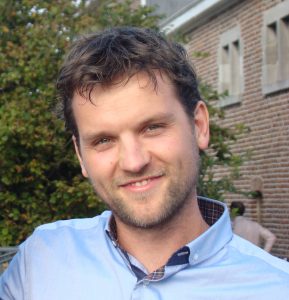Innovative technologies for intrauterine monitoring of predictive markers of vascular and neurological well-being
Dr. Silvia Visentin, Ph.D.
Department of Woman’s and Child’s Health
University of Padua (IT)
Fetal ultrasound (US) imaging plays a fundamental role in the monitoring of fetal growth during pregnancy and in the measurement of the fetus well-being. Growth monitoring is becoming increasingly important since there is an epi- demiological evidence that abnormal birth weight is associated with an increased predisposition to diseases related to cardiovascular risk (such as diabetes, obesity, hypertension) in young and adults. The interest for measuring the diameter and intima-media thickness of major vessels has stemmed from its importance as biomarker of hypertension damage and atherosclerosis in adults. Well-established animal models have shown that the environment (diet, diabetes, hormone exposure, hypoxia) induces an increased risk of a variety of diseases later in life with similar phenotypic outcomes in target organs. This suggests that a range of disruptions in fetal and postnatal growth may act through common pathways to regulate the developmental programming and produce a similar adult phenotype.
In utero, identification of high risk fetuses and long-term follow-up are necessary to assess the effects of interventions aimed at preventing pregnancy-induced hypertension, reducing maternal obesity, encouraging a healthy life style and preventing childhood obesity on adult blood pressure and cardiovascular disease in later life. Moreover, a reduced fetal growth may be associated with poorer neurodevelopmental outcomes compared to being appropriate for gestational age. Assessing cognitive and motor development is not an easy task. It is particularly difficult to assess the prevalence of ‘abnormal’ neurodevelopment in a ‘normal’ population. The fetal ante-partum and intrapartum monitoring of fetal well being allows to control the fetal response to the ischemic phenomena related to contractile activity, above all in presence of a placental insufficiency.
The cardiotocography presents a double purpose: identify a suspected fetal compromise from hypoxygenation, i.e. identify the clinical situations in which, due to the risk that exists, there can be one hypoxia; evaluate the clinical situation in which it is necessary to intervene before hypoxygenation transform and land at an irreversible point which is metabolic acidosis. Finally, it should not be forgotten that the purpose of fetal surveillance is only that prevention of mortality and not fetal morbidity.
Back to the future: prenatal life and perinatal programming
Prof. Vassilios Fanos
Neonatal Intensive Care Unit, Neonatal Pathology and Neonatal Section
Azienda Ospedaliera Universitaria and University of Cagliari (IT)
David Barker was one of the physicians who in the last decades brought about the greatest changes in medicine, changes so important as to represent a veritable revolution in medical thought. Following his theory, not only is the neonate (and even more so the fetus) not a small adult, but perhaps the neonate is the “father” of the adult person. Most of our destiny in health and disease throughout adult life has been decided and traced in our mothers’ wombs. The concept of perinatal programming has become more and more accepted as: “The response by a developing organism to a specific challenge during a critical time window that alters the trajectory of development qualitatively and/or quantitatively with resulting persistent effects on phenotype”. There are several contributions on the outstanding role of early epigenetic mechanisms and the future adult life of each individual. The effects of prenatal diagnosis on relevant neonatal pathologies, such as prematurity, perinatal asphyxia, infections and sepsis will be discussed.
Fetal cardiological diagnostics in the clinical practice
Dr. Roberto Tumbarello, Ph.D.
Complex Structure of Pediatric Cardiology
Hospital G. Brotzu, Cagliari (IT)
Fetal echocardiography is the primary method for diagnosing fetal cardiovascular disease and for monitoring progression and managing the disease process. A complete fetal echocardiogram is similar in scope to a posthnatal transthoracic echocardiogram. Cardiac and great vessel anatomy and relationship cardiac function blood flow pattern and cardiac rhythm are all assessed. A wide range of cardiovascular diseases can be detected and defined in the fetus including simple and complex cardiovascular strucural malformations, cardiomiophathy, tumors and arrhythmias.
Because a complete diagnostic fetal echocardiography is time-consuming and labor-intensive, fetal echocardiography is not suited for routine screening of all pregnant woman. Thus, it is important to develop a strategy for appropriate, targeted referrals for fetal echocardiography. The general indications for fetal echocardiography are primarily maternal, familial or fetal.
Abnormalities of cardiac rhythm can be diagnosed accurately during prenatal life. Rhythm disturbances are of clinical importance because some types are associated with fetal compromise, which may lead to the in utero or postnatal demise of the affected fetus. Many form of rhythm disturbance, notably tachycardia, respond to prenatal drug theraphy which greatly improves the prognosis. Thus, precise assessment of the nature of fetal arrhythmias is essential so that, where indicated, appropriate therapy may be commenced.
Unfortunately fetal elettrocardiogramare is difficult to interpret because of the absence of the fetal P waives, extraneous electrical noise and the inability to recognise changes in QRS morphology. Nonetheless accurate diagnosis and treatment of fetal arrhythmias are important to avoid unnecessary cesarian section of fetal death. Fetal echocardiography has been proven to be very useful in the accurate diagnosis of fetal arrhythmias in the majority of the cases. With this method the electrical attivation sequence of the atria and ventricle is inferred from the mechanical events detected by echocardiography.
Real-time telecardiology: methods and tools
Dr. Francesca Frexia
Healthcare Flows Research Program / Data-intensive Computing Sector
CRS4 – Center for advanced studies, research and development in Sardinia, Pula (IT)
This talk provides an overview about the open source platform developed by CRS4 to support real-time telemedicine.
Standard telemedicine technology proves its validity in several contexts but is generally unsuitable to situations involving operator-dependent diagnostic techniques. In these cases, common store-and-forward telemedicine solutions are not sufficient, as timely application of specific expertise is essential the in order to complete effectively the examination itself. Real-time collaboration is therefore necessary and must be supported by ad-hoc telemedicine solutions, which are usually proprietary, expensive and requires dedicated networks. Pediatric Cardiology is one of those clinical discipline depending upon a specialized operator to obtain a reliable result: echocardiography is the main means of a congenital heart disease (CHD) evaluation, and it is only accurate when performed by an expert. In general, specialists in this fields are rare and their lack is particularly critical in some regions with high incidence of this kind of disease, like Sardinia. CRS4 and Brotzu Pediatric Cardiology carried out a research project resulting in a platform enabling real-time echocardiographic exams to be performed remotely, without physical interaction between the patient and the specialist. The ultrasound analysis is operated by a clinician who physically visits the patient, while the specialist guides the operator directly, viewing the echographic output and the examination scene at the same time.
The platform developed by CRS4 is open source and inexpensive. It comes with two versions: desktop (apple based) and mobile (android based). The system is based on COTS hardware, doesn’t need dedicated networks and also allows to connect old echographic devices, as long as they have a video output.
Telecardiology live demo
Dr. Mauro Del Rio & Dr. Vittorio Meloni & Dr. Roberto Tumbarello
Healthcare Flows Research Program / Data-intensive Computing Sector
CRS4 – Center for advanced studies, research and development in Sardinia, Pula (IT)
and
Complex Structure of Pediatric Cardiology
Hospital G. Brotzu, Cagliari (IT)
In this practical session, the CRS4 real-time telemedicine platform presented during the lecture “Real-time telecardiology: methods and tools” will be showed in action.
From technology innovation to clinical implementation – a perspective from the industry
Dr. Rick Bezemer, Ph.D.
Program Lead Perinatal Care Solutions
Philips Research, Eindhoven (NL)
To successfully develop new technologies ‘from bench to bedside/incubator’ and implement innovations in care practices and routines, deep understanding of the ‘wants’ and ‘needs’ of the customers and end-users is crucial. Here, we will discuss several key aspects essential for impactful research and development in healthcare, including value proposition creation, IP generation, and co-creation. Furthermore, we will dive deeper into the current trends, challenges, and needs observed in the Perinatal Care domain, and we will end with an overview of current Philips solutions for fetal and neonatal monitoring, and some highlights on ongoing research.
Fetal Cardiac Signal Processing Techniques
Prof. Reza Sameni, Ph.D.
School of Electrical & Computer Engineering
Shiraz University, Shiraz, Iran
In this workshop, the major signal processing techniques which have been developed for the extraction and analysis of the fetal electrocardiogram (fECG) from noninvasive maternal abdominal recordings over the past fifty years are reviewed and compared with one another in detail.The topics covered in the workshop are organized in two parts:
Part I:
1- The electrophysiology of the fetal ECG from the signal processing viewpoint
2- The physics of single and multichannel fetal ECG measurement
3- The major interferences of the fetal ECG, including the maternal ECG, muscle contractions, power-line interference, device noises, etc.
4- Naïve extraction and filtering techniques, including visual inspection, template subtraction and conventional filters
Part II:
5- Model-based and adaptive filtering techniques for fECG noise/interference cancellation
6- Blind and semi-blind techniques for fECG noise/interference cancellation
7- Advanced issues: post-processing and fECG parameter extraction, real-time and online fECG extraction, fECG extraction from twins
The workshop participants will find the chance to work with real fECG signals and to experience the presented signal processing techniques during the Matlab laboratory.
T-Wave Alternans Identification in Direct and Indirect Fetal Electrocardiography
Dr. Laura Burattini, Ph.D.
Department of Information Engineering
Polytechnic University of Marche (IT)
Cardiac repolarization abnormalities manifest as T-wave anomalies in electrocardiograms and highlight severe (lethal in some cases) cardiovascular disorders and heart instabilities. Among T-wave anomalies, T-wave alternans is widely analyzed because of its link with sudden cardiac death. Fetal T-wave alternans (FTWA) is a still little-known marker for severe fetus-heart instabilities and may be related to some currently unjustified fetal deaths. Automatically detecting TWA on direct fetal electrocardiograms (DFECG) means possibility of providing fetuses the right treatment during delivery. Instead, automatically identifying TWA on indirect fetal electrocardiograms (IFECG) means possibility of providing fetuses the right treatment even during pregnancy, when taking actions for outcome improvement is still possible. Moreover, TWA identification from IFECG is noninvasive, and thus safe for both fetuses and mothers. The heart-rate adaptive match filter (HRAMF) represents a valid tool for automatic TWA identification in both IFECG and DFECG.
Ultrasound imaging: from physics to fetal anatomical measurements
Prof. Massimo Mischi, Ph.D.
Department of Electrical Engineering
Signal Processing Systems Group, Diagnostics Research Lab
Eindhoven University of Technology (NL)
The basic principles of ultrasound will be discussed. This includes the generation of ultrasound pressure waves through electro-mechanical conversion, their propagation through lossless and lossy media, and the formation of ultrasound images using array transducers. Special attention will be dedicated to the system resolution, which affects the accuracy of the standard anatomical measurements performed on the fetus during pregnancy. Spatial sampling and its impact on the image quality (grating lobes) will also be discussed. Latest developments, such as dynamic 3D and ultrafast imaging, will also be briefly presented, along with their expected impact on pregnancy monitoring.
Ultrasound Doppler: from physics to fetal functional measurements
Prof. Massimo Mischi, Ph.D.
Ultrasound Doppler is the leading technology for the estimation of blood velocity. To this end, the Doppler principle is exploited in several ways through various implementations. The available solutions, ranging from pulsed- to continuous-wave Doppler, will be amply discussed and critically evaluated with respect to their advantages and limitations. Ultrasound Doppler is especially interesting for monitoring the fetal health condition, providing information on the cardiovascular function and oxygenation levels by probing the flow conditions in the fetal heart and through the umbilical cord. The latter is essential for the exchange of oxygen and nutrients through the placenta. Doppler images can also be generated by color coding the estimated velocities, providing an additional valuable tool (color Doppler) to investigate the cardiac function and diagnose congenital heart disease.
Fetal Magnetocardiography
Prof. Silvia Comani, Ph.D.
BIND – Behavioral Imaging and Neural Dynamics Center
Dept. of Neuroscience, Imaging and Clinical Sciences
University “G. d’Annunzio” of Chieti-Pescara (IT)
Fetal magnetocardiography (fMCG) is recently established method for the non-invasive assessment of fetal heart function. The method is based on measurements of the magnetic fields produced by the electric activity in the fetal heart. The advantage of magnetic measurements is a significantly smaller amount of volume conductor influence as compared to electric measurements, which is especially important in the last trimester of gestation due to the electrically highly insulating vernix caseosa. One drawback is the very weak signal produced by the fetus, which makes very sensitive magnetic recording techniques and good shielding against external disturbances necessary.
In this talk, the magnetic field recording techniques will be presented. Superconducting QUantum Interference Devices (SQUIDs) are the most sensitive commercial magnetic field or flux detector. Standard systems comprise about 50 to 300 SQUID sensors arranged in a fixed layout inside a cryostat and cooled by liquid helium. Alternative sensors operating at room temperature have been proposed. For example optical magnetic field sensors (optical pumping magnetometers) have the capability to record the fetal magnetocardiogram. The fact that optical magnetic field sensors do not need to be cryogenically cooled enables implementation of sensor modules that can be arranged in any geometrical configuration as required by the various clinical applications.
Finally, some analytical solutions for the extraction of reliable fetal cardiac signals from magnetic recordings will be presented, as well as some research and clinical applications.
Cardiotocography for fetal monitoring and physiological rationale behind it
Prof. Giovanni Magenes, Ph.D.
Department of Industrial and Information Engineering
University of Pavia (IT)
The cardiotocography (CTG) has been introduced in the early ‘70ies as a clinical test for checking fetal well-being during pregnancy and at the moment of delivery. Its basic physical principles will be illustrated and a critical review of the traditional approach in reading CTG tracings will be done. The lecture will focus on the extraction of several time domain and frequency domain parameters of Fetal Heart Rate (FHR) time series and their physiological meaning. Some examples extracted from a real clinical database will be analysed and discussed by means of the software we developed since the year 2000 in collaboration with Hewlett-Packard – Italy.
Advanced signal processing and modelling techniques in Fetal Heart Rate signal analysis
Prof. Maria Gabriella Signorini, Ph.D.
Department of Electronics, Information and Bioengineering – DEIB
Politecnico di Milano (IT)
Objective of the lesson is to present and discuss some key points about the analysis of fetal heart rate (FHR) recorded by means of CardioTocography (CTG) starting from the research activity in the last twenty years.
The approaches adopted for the analysis considered traditional time domain parameters, frequency domain approaches as well as new indices in the nonlinear field such as entropy measures, complexity parameters and indices derived from Lempel Ziv and phase rectified signal averaging method.
Our view is the traditional clinical analysis can be improved by adding new knowledge from parameters that are able to capture different aspects of the physiological control systems in the fetal heart.
The integration of various computational methods allows extracting reliable parameters from FHR variability. Results obtained in Normal fetuses and in IUGR populations will be examples to show how the different methods work and their classification performances. Moreover, the integration of linear and nonlinear parameters in CTG analysis can provide reliable indications about pathophysiological fetal states,
Open questions are about their possible use to support early clinical diagnosis of fetal pathologies and
if and when these novel features should be considered in a novel fetal monitoring system design.
Intrapartum Fetal Heart Rate Analysis: from fractal features to sparse feature-selection based Classification
Prof. Patrice Abry, Ph.D.
Signal, System and Physics statistical signal processing research group
Physics Department
Ecole Normale Supérieure de Lyon (FR)
Fetal Heart Rate (FHR) monitoring is routinely used in clinical practice to help obstetricians assess fetal health status during delivery. However, early detection of fetal acidosis that allows relevant decisions for operative delivery remains a challenging task, receiving considerable attention. The present work renews FHR analysis and fetal acidosis detection in two ways. First, fractal based features are shown to constitute relevant tools for the assessment of cardiac variability, that significantly outperform and thus satisfactory replace other traditional assessment of cardiac variability such as LF/HF ratio, that relies either on the splitting into a priori chosen frequency bands of the spectral contant of data, or on spectral and DFA based scaling exponents. Second, fetal acidosis detection is commonly formulated as a pH based classification problem. Our original proposition is to promote Sparse Support Vector Machine classification that permits to select a small number of relevant features as well as to achieve efficient fetal acidosis detection. Concepts and tools are illustrated at on a large (1288 subjects) and well documented database, collected at french public academic Hospital in Lyon. It is shown that the automatic selection of a sparse subset of features achieves satisfactory classification performance (sensitivity 0.73 and specificity 0.75, outperforming clinical practice). The subset of selected features receive simple interpretation in clinical practice. A second large database collected in Czech Republic is further used to show the generalization ability of both fractal features and Sparse Support Vector Machine classification.
Monitoring uterine activity during pregnancy and delivery by electrohysterography: background, modeling and signal analysis
Dr. Chiara Rabotti, Ph.D.
Department of Electrical Engineering
Signal Processing Systems Group, Diagnostics Research Lab
Eindhoven University of Technology (NL)
Uterine contraction monitoring is part of established clinical practice during parturition. Classically, the response of the fetal heart rate to the compressing effect of uterine contractions is evaluated on tocogram traces as a ‘non-stress test’. Yet, the potential diagnostic value of uterine activity assessment goes far beyond its current use in the clinic. In fact, it could be of great value in the prediction of preterm delivery, one of the biggest challenges faced by gynecologists nowadays. Motivated by the limitations of available techniques for contraction monitoring, in the last decade research on the electrohysterogram (EHG), the non-invasive measurement of the electrophysiological signal driving the mechanical contraction of the uterus, has gained momentum.
Research has approached the EHG from very different angles, ranging from developing EHG-based methods to replace current (invasive) clinical standards, up to estimating parameters for the prediction of (preterm) delivery and modeling the biophysical processes underlying the generation of the EHG signal. The aim of this contribution is to dive into the methods that have been developed for the analysis of the EHG focusing on algorithms tailored to the underlying electrophysiological model. To this end, aspects as uterine physiology and related models will be introduced as a basis for an in-depth discussion of the optimal signal acquisition strategies and analysis methods. Starting from the specific application of uterine activity monitoring, recent advances on both single-channel as well as multi-channel (model-based) signal analysis techniques will be elaborated. The applicability of the discussed methods in different applications/fields will be part of the concluding remarks.
Innovative devices and techniques for multimodal fetal health monitoring
Dr. Michiel Rooijakkers, Ph.D.
Bloom Technologies
San Francisco, CA (USA)
Throughout history various techniques have been used to monitor maternal and fetal health during both pregnancy and delivery. Some health indicators, like the presence of fetal movement and uterine activity can be sensed by the mother, while others might require the use of measurement equipment or the knowledge and skills of a trained physician. Both can benefit from new and improved measurement techniques and devices.
During this lecture, an overview is given of various new and innovative devices for multimodal fetal and maternal monitoring throughout pregnancy and delivery, including the ways they might help improve patient comfort, decision making, and maternal and fetal outcome, while reducing the current strain on the healthcare system. We’ll also have a more in-depth look at a couple of devices, measurement methods, and analysis techniques used in the detection of a of pregnancy-related health features.
Advanced Signal Processing Algorithms for Cardiorespiratory Monitoring in the Neonatal Intensive Care Unit
Prof. Riccardo Barbieri, Ph.D.
Department of Electronics, Information and Bioengineering
Politecnico di Milano (IT)
Heart rate variability (HRV), generally defined as the variations of heart rate (HR) around its mean, is an important quantitative marker of cardiovascular regulation by the autonomic nervous system. From the first HRV electrocardiographic studies, over 40 years ago, it was clear that R-wave to R-wave (R-R) interval dynamics contain well-defined rhythms associated with autonomic tone, encouraging further investigation and leading, in 1996, to definition of a set of standard HRV measures. To date, despite HRV has been evaluated in thousands of studies to characterize and diagnose diseases that affect the autonomic nervous system, accurate personalized solutions for clinical and everyday monitoring are still under scrutiny. This presentation focuses on our recently derived definitions of HR and HRV based on explicit point process Bayesian probability models. Point process models give a physiologically sound representation of the stochastic structure generating the heartbeat and they allow for instantaneous assessment of fast, non-stationary dynamics, allowing for the possibility for inclusion of other cardiovascular variables, such as arterial blood pressure and respiration, at any required time scale.
After going over the main methodological highlights, this lecture presents some of the most relevant applications of point process analysis of heartbeat time series, bringing attention on an exemplary application data from the neonatal intensive care unit (NICU) at the University of Massachusetts Memorial Healthcare (available at http://physionet.org). Here, point process analysis reveals instantaneous measures that can be used to predict infant bradycardia, pointing at our framework as significantly relevant to risk stratification, predictive monitoring, and implementation of preventative strategies for reducing morbidity and mortality associated with bradycardia in neonatal intensive care units.
Fetal Cardiac Signal Processing in Matlab – Part 1
Prof. Reza Sameni, Ph.D.
School of Electrical & Computer Engineering
Shiraz University, Shiraz, Iran
The workshop participants will find the chance to work with real fECG signals and to experience the presented signal processing techniques during the Matlab laboratory. The lab session will cover:
1- Visual inspection of real fetal ECG recorded from scalp leads and maternal abdominal leads in single and multiple pregnancies
2- fECG extraction by template subtraction
3- Preprocessing noninvasive fECG recordings
4- Adaptive filters for maternal ECG(mECG) cancellation
5- Extended Kalman filters for maternal ECG(mECG) cancellation
6- fECG extraction using independent component analysis (ICA)
7- fECG extraction using periodic component analysis (ΠCA)
Fetal Cardiac Signal Processing in Matlab – Part 2
Prof. Reza Sameni, Ph.D.
School of Electrical & Computer Engineering
Shiraz University, Shiraz, Iran
The workshop participants will find the chance to work with real fECG signals and to experience the presented signal processing techniques during the Matlab laboratory. The lab session will cover:
8- fECG extraction using a deflation iterative procedure
9- fECG extraction using online ICA
10- Post-processing the extracted fECG
11- Fetal heart rate calculation and refining
12- Fetal average beat calculation
13- Extracting morphologic parameters from the fECG
14- A realistic model of maternal abdominal recordings
Multifractal analysis and sparse machine learning in Matlab
Prof. Patrice Abry, Ph.D.
Signal, System and Physics statistical signal processing research group
Physics Department
Ecole Normale Supérieure de Lyon (FR)
This lab. work will review the basics in scale-free and multifractal analysis and in sparse machine learning. First, it will introduce the use of wavelet transforms and wavelet leaders for the analysis of scale-free dynamics and the estimation of the corresponding self-similarity and multifractal exponents. Second, it will illustrate the benefits of sparse machine learning for fetal acidosis detection.
Requirement:
Computers with Matlab + the toolbox at
http://www.ens-lyon.fr/PHYSIQUE/Equipe3/Multifractal/software.html
must be downloaded.
◊ ◊ ◊



























